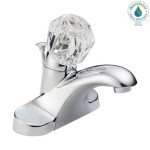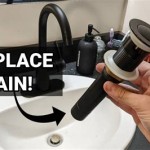How to Replace a Shut-Off Valve in a Bathroom Sink
Bathroom sink shut-off valves are essential components that control the flow of water to your faucet. These valves can wear out over time, leading to leaks, drips, and even complete failure. When a shut-off valve malfunctions, it can be frustrating and inconvenient, disrupting your daily routine. Fortunately, replacing a shut-off valve is a relatively straightforward DIY project that most homeowners can tackle with the right tools and knowledge.
This article will guide you through the process of replacing a bathroom sink shut-off valve, providing step-by-step instructions and essential tips for a successful repair. Before you begin, ensure you shut off the water supply to the sink, gather the necessary tools, and take precautions to protect yourself and your surroundings from potential water damage.
Step 1: Shut Off the Water Supply
The first step is to shut off the water supply to the bathroom sink. Locate the main water shut-off valve for your home, typically found near the water meter. Once the valve is located, turn it clockwise until it is completely closed. This will prevent water from flowing into the sink while you work on replacing the valve.
To confirm that the water supply is shut off, turn on the faucet of your bathroom sink. If no water flows, the valve is successfully closed. If water continues to flow, investigate the valve and ensure it is fully closed or locate a secondary shut-off valve specifically for the sink.
Step 2: Drain the Water from the Pipes
After shutting off the main water valve, drain the water from the pipes leading to the sink. This step is crucial to prevent water from spilling out during the valve replacement process. Open the hot and cold water faucets of the bathroom sink and allow the water to drain completely.
If you have a drain plug in your sink, remove it to ensure that the pipes are fully drained. If the drain is slow, consider using a plunger to help remove any remaining water. Once the water has drained, you can proceed to the next step.
Step 3: Disconnect the Old Shut-Off Valve
With the water supply shut off and the pipes drained, you can begin disconnecting the old shut-off valve. Inspect the valve to identify the type of connection used. Common types include compression fittings, threaded fittings, and push-to-connect fittings.
For compression fittings, use an adjustable wrench to loosen the nut securing the valve to the water supply pipe. For threaded fittings, use a pipe wrench to unscrew the valve from the pipe. Be careful not to overtighten the wrench, as this can damage the pipes. For push-to-connect fittings, gently pull the valve out from the pipe.
Once the valve is disconnected from the supply pipe, you can disconnect it from the faucet. This is typically done by loosening the nut connecting the valve to the faucet's supply lines using a wrench.
Step 4: Install the New Shut-Off Valve
With the old valve removed, you can now install the new shut-off valve. Before installing the new valve, ensure that the pipe threads are clean and free of debris. If necessary, use a pipe thread cleaner to remove any obstructions.
Apply a thread sealant tape to the threads of the new valve. This will create a watertight seal and prevent leaks. Carefully screw the new valve onto the water supply pipe. Ensure that the valve is properly aligned with the pipe and tighten it securely with a wrench.
If the new valve has compression fittings, tighten the nut connecting the valve to the pipe until it is snug. Do not overtighten, as this can damage the pipe or the valve. If the new valve has push-to-connect fittings, push the valve firmly into the pipe until it clicks into place.
Step 5: Connect the New Valve to the Faucet
With the new valve installed, connect it to the faucet. This step may vary depending on the type of faucet you have. Typically, you will need to connect the valve's outlet to the faucet's inlet using flexible supply lines.
Ensure that the supply lines are properly connected to the valve and the faucet. Tighten the nuts securing the lines with a wrench, but do not overtighten. If the faucet uses rigid supply lines, ensure that the fittings are properly aligned and tightened.
Before turning the water supply back on, check all connections for leaks. If you find any leaks, tighten the connection until the leak stops. If a leak persists, you may need to replace a damaged fitting or tighten the connection more firmly.
Step 6: Turn the Water Supply On
Once you have inspected all the connections and ensured there are no leaks, you can turn the water supply back on. Turn the main shut-off valve counterclockwise until it is fully open.
Allow the water to flow for a few minutes, checking for any leaks at the new valve or the faucet. If no leaks are detected, your new shut-off valve is successfully installed.
Step 7: Test the Water Flow
After turning the water supply on, test the water flow. Turn on the hot and cold water faucets of the bathroom sink and ensure that the water flows freely. If you encounter any issues with the water flow, check the connections again to ensure that they are secure.
If the water pressure is low or the water flow is restricted, it might be necessary to adjust the valve or further investigate the problem. If you are unsure about the cause, it is best to consult a qualified plumber for assistance.

How To Replace A Leaking Shutoff Valve Under Sink

How To Install Water Shut Off Valve For Sinks

How To Replace Shutoff Valve Under Bathroom Sink

How To Remove Install A Leaky New Shut Off Valve Compression Soldered Or Push Fit Got2learn

How To Replace A Shutoff Valve Diy Family Handyman

How To Replace A Shut Off Valve Under Your Sink

How To Install A New Bathroom Water Supply Shutoff Valve

Replace Bathroom Sink Shut Off Valve

How To Replace A Flowtite Push Pull Valve With Standard Shut Off For Dishwasher

How To Replace Shut Off Valve On Cpvc Pipe Замена крана на пвх трубе
Related Posts







